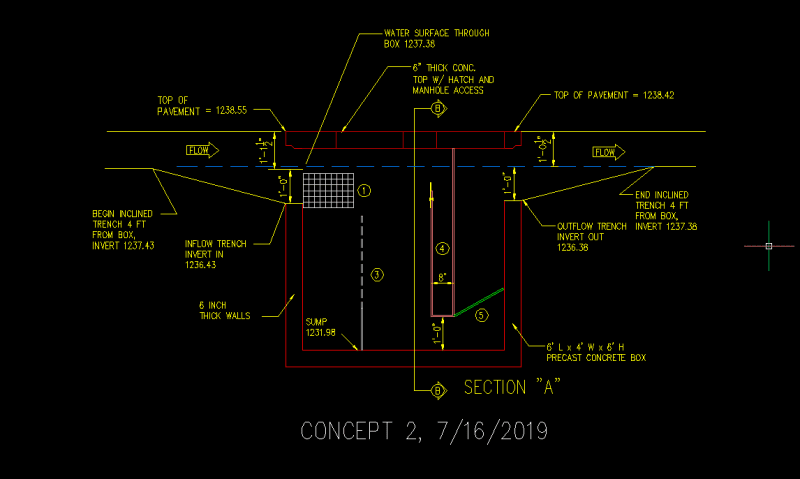The site is an industrial scale meal loadout facility. They transfer soy beans and soy bean meal to trucks to be distributed to chicken and hog farms. The transfer hoppers are in a metal shed building on a concrete slab with basically no slope, and the pavement into and out of the building has very little slope on it as well. The only catch basin nearby is very shallow and cannot be deepened due to site constraints. The building catches meal dust, and the client needs to pressure wash the dust regularly, but it creates a maintenance problem because the meal dust runs off.
The project is to build a properly traffic rated, heavy duty trench drain system, in concert with busting up the pavement and repaving with enough cross slope to where the pad inside and around the building drains properly. The client would like to have some kind of interceptor between the trench drains and the inlet, to catch as much meal dust as possible during washdown. There aren't any NPDES concerns because the site ultimately drains to a stormwater spill containment pond which receives adequate treatment, but they'd like to catch this material before it gets there if possible.
The problem is we only have about 18 inches of cover to work with at the inlet, so the trench drains must basically run the entire distance to the inlet. Not enough cover for a pipe.
So I want to put in an oil grit separator, or grease trap, of some kind in-line that has a 1 ft deep trench drain in, and another 1 ft deep trench drain out, that will catch surface particulates, many of which will likely be floating, some of which might not be. Any good ideas on how to design this? Any precast options that come to mind? How would you folks do it?
Hydrology, Drainage Analysis, Flood Studies, and Complex Stormwater Litigation for Atlanta and the South East -
The project is to build a properly traffic rated, heavy duty trench drain system, in concert with busting up the pavement and repaving with enough cross slope to where the pad inside and around the building drains properly. The client would like to have some kind of interceptor between the trench drains and the inlet, to catch as much meal dust as possible during washdown. There aren't any NPDES concerns because the site ultimately drains to a stormwater spill containment pond which receives adequate treatment, but they'd like to catch this material before it gets there if possible.
The problem is we only have about 18 inches of cover to work with at the inlet, so the trench drains must basically run the entire distance to the inlet. Not enough cover for a pipe.
So I want to put in an oil grit separator, or grease trap, of some kind in-line that has a 1 ft deep trench drain in, and another 1 ft deep trench drain out, that will catch surface particulates, many of which will likely be floating, some of which might not be. Any good ideas on how to design this? Any precast options that come to mind? How would you folks do it?
Hydrology, Drainage Analysis, Flood Studies, and Complex Stormwater Litigation for Atlanta and the South East -

